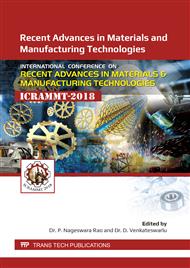p.834
p.839
p.846
p.852
p.858
p.864
p.870
p.876
p.882
Thermal Analysis of Dissimilar Materials Diffusion Bonding Using Finite Element Method
Abstract:
Finite element method (FEM) is employed to study an effect of diffusion bonding strength between aluminium and its copper material and optimized parameters. The diffusion bonding soundness was estimated at different processing parameters such as temperature, pressure and time. The coefficients of linear thermal expansion (CTE) of the metals induce thermal stress at the bonded area. This phenomenon motivated the study of the stress distribution along with maximum and minimum stress values, while bonding of two dissimilar metals at particular bonding process parameters. The incompatible thermal stress at the bonded area plays a vital role in better bond soundness. Thus, it is required to estimate the bonding interface in dissimilar joints. This study was performed using the FEM and the analysis was carried out using the commercial software package Ansys V12.0
Info:
Periodical:
Pages:
858-863
Citation:
Online since:
August 2019
Price:
Сopyright:
© 2019 Trans Tech Publications Ltd. All Rights Reserved
Share:
Citation:


